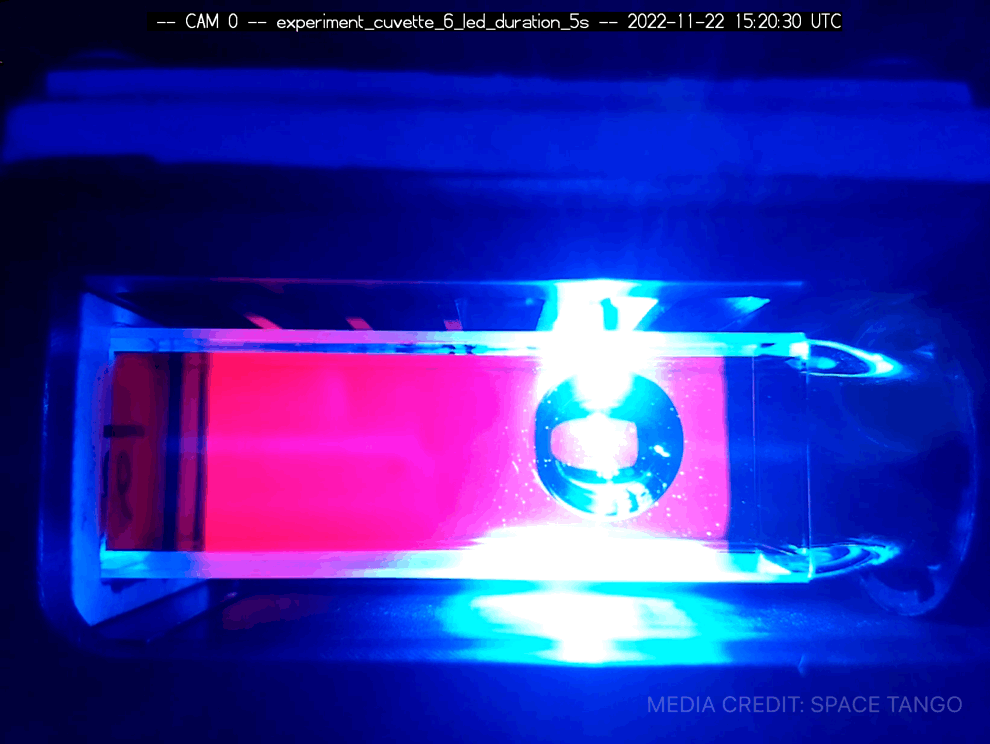
We use cookies to ensure that we give you the best experience on our website. If you continue to use this site we will assume that you are happy with it.
Ok ✕
Principal Investigator: Yangying Zhu, Ph.D., University of California Santa Barbara

Space Tango engineered photo-responsive surfactants that reversibly switch their molecular structures upon illuminating appropriate wavelengths and changing the fluids’ interfacial tension on demand. The CubeLab in this investigation applied the required wavelength to a bubble causing a gradient in the tension to form a Marangoni flow in the fluid. The Marangoni flow exerts a new force on a bubble in the opposing direction, causing it to depart from the substrate into the bulk fluid. This leads to the bubble being “pinched off” with control, promoting bubble departures during boiling to enhance thermal transport.
What science requirements guided the selection of science interface systems?
The most impactful science requirements for the payload design were the LED power output and lighting protocols and the use of photo-responsive surfactants by the University of California Santa Barbara (UCSB) team. They were the most impactful because they were pivotal in forming and observing the Marangoni effect. The LEDs had to meet the specific wavelength requirements of the various photo-responsive surfactants. The storage vessels, or observation cuvettes, for the surfactant, had to be optically clear to allow adequate exposure from the LEDs, and the mounting hardware for those cuvettes had to have an appropriate level of blocking light between the different surfactants.
How was the science loaded? Who loaded the science? What did the integration process look like?
The photo-responsive surfactants were prepared and loaded into the observation cuvettes by the UCSB team at Space Tango’s labs HQ in Lexington. Once loaded with surfactants, the observation cuvettes were handed over to the Space Tango team for integration into the CubeLab. Each observation cuvette was carefully inserted, one by one, and secured within the internal mounting hardware. Completing the CubeLab assembly, a quick checkout was performed with the imaging system to confirm the camera placement, focus, and integrity of the observation cuvettes.
What equipment was used to get to microgravity? If applicable, how was the science kept alive? Describe the facilities used (PAUL, TangoLab, CMC/ Cold Stow, etc.).
While this investigation did not require temperature controls to maintain the integrity of the surfactants, they can degrade over time and with a usable lifespan of one month. To avoid degradation, the investigation was promptly returned in ambient conditions.
What did the de-integration process look like?
The CubeLab was shipped to Space Tango HQ after its return to Earth, where a formal deintegration process occurred. An internal system checkout was performed with the cuvette cameras before beginning. De-integration consisted of disconnecting the mounting hardware, then individually removing the cuvettes. The cuvettes were packaged in the shipping hardware provided by UCSB and returned to their facility for analysis.
What did the on-orbit data look like? What details were communicated via the partner portal? Describe how custom this can be. Closing with this highlights the end-to-end prioritization of science.
The investigation dashboard for UCSB featured standard CubeLab environmental data such as humidity and temperature and protocol and timing actions associated with each experiment run. Predefined parameters were uploaded to the experiment and executed using an automated script. The script cycled through various LED “on” times to move a bubble through a fluid using the Marangoni effect. This behavior was recorded using video and provided to the partner within several hours using Space Tango’s custom Partner Portal. The partner was able to analyze the videos and suggest a different set of parameters to be uploaded and executed on subsequent experiment runs. Space Tango’s automated technology enables the implementation of feedback from the principal investigator and the rapid iteration of on-orbit parameters.